Larch Trees: Types, Leaves, Cones, Flowers – Identification Guide (Pictures)
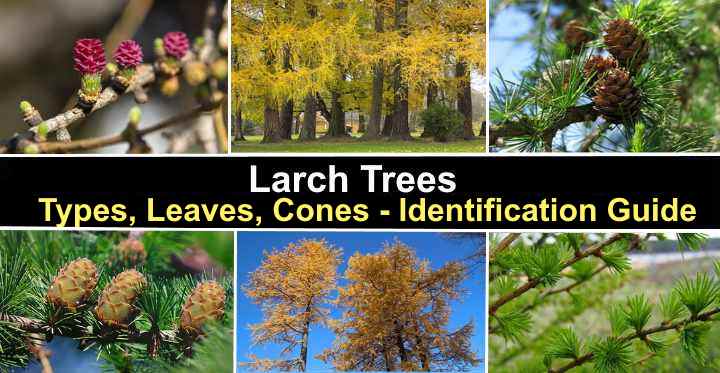
Larch trees (botanical name Larix) are tall deciduous conifers with soft needle-like leaves growing radially in small tufts on branches. Larch trees are identified by their pyramidal growth, typical of most conifer species. However, unlike most conifers, larch trees turn golden yellow in the fall before dropping their leaves. Typically, larches are the first deciduous trees to grow leaves in the spring.
Larch trees are native to cool, temperate climates of the Northern Hemisphere. Larch trees are found in states such as Washington, Oregon, Montana, Minnesota, and West Virginia. North American larch trees also grow in the subalpine forests of Canada and Alaska.
The two most popular species of larch are the American Larch (Larix laricina)—also called tamarack—and the Western Larch (Larix occidentalis). These tall conical conifers grow between 30 and 70 ft. (10 – 21 m) tall.
This article is a complete guide to identifying the most popular types of larch trees growing in temperate and subarctic forests of North America, Europe, and Asia. Descriptions of the deciduous conifers and pictures of larch tree bark, leaves, cones, and flowers will help identify the different Larix species.
Larch Tree Facts
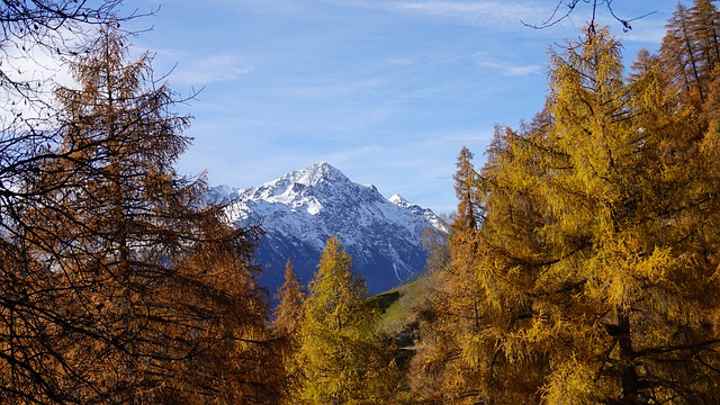
Larch trees are tall deciduous conifers that are cold hardy
Larch is a species of deciduous, coniferous tree in the genus Larix and pine family Pinaceae. There are between ten and twelve species of larch trees. Like most conifers, the large trees have a conical, pyramid-like growth. Larches are also tolerant of freezing temperatures, and they thrive growing in zones 2 through 5.
The difference between larches and most coniferous trees is that larch trees are deciduous trees that lose their needle leaves in the fall. When the leaves of larch trees turn color in the fall, their greenish-yellow to golden yellow colors contrast with evergreen fir trees, hemlocks, cedars, and junipers.
States where larches grow, such as Washington, are popular destinations for hikers in the fall. The beauty of the yellow larches in autumn and the evergreen conifers create a stunning mountainous landscape.
Like pine trees, larches have needle leaves and seed-bearing cones. Unlike pines, larch trees lose their leaves in winter and have a bare look. The small colorful larch cones give the appearance that the larch has flowers.
Larch trees are generally fast-growing deciduous conifers that live for hundreds of years.
Larch Tree vs. Tamarack
The most distributed larch tree in North America is the tamarack. Tamarack is another name for the eastern or American larch (Larix laricina). Other names for this common larch tree include hackmatack, black larch, and red larch. Tamaracks are widely distributed throughout the northern states of the US.
Tamarack is a small to medium-sized tree growing up to 60 ft. (18 m) tall. Tamaracks grow widely in Newfoundland, Minnesota, West Virginia, Montana, and Wisconsin. The small flower-like cones on tamarack trees are the smallest of the larch species. The cones start as bright red before maturing to brown.
Larch Tree Leaves
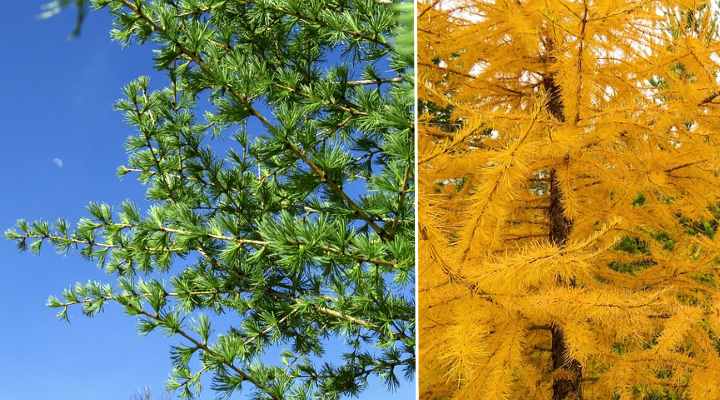
Larch tree leaves are needle shaped and turn yellow in autumn before shedding their leaves
Larch tree leaves are soft, flat needle-shaped leaves characteristic of many pine trees. The slender, pointed green larch leaves grow in tufts from woody pegs and measure up to 2” (5 cm) long. There are between 15 and 30 needle-like leaves growing from each peg. Some other larch species, such as the subalpine larch, has up to 40 needles on a woody peg.
The identifying feature of larch trees is the beautiful yellow color of the needle leaves in the fall. Larches are one of the few types of conifers to shed their leaves in the fall. In autumn landscapes, coniferous and deciduous forests turn into patches of warm bronze-yellow colors when the larches turn their fall color.
Larch Flowers

A close up picture of larch flowers (larch seed cones): female flowers on the left picture and male flowers on the right picture
Larch trees don’t have flowers, but they have small male and female immature flower-like seed cones, called strobili, made up of scaly bracts growing on the same tree.
The colorful female larch flowers (or cones) can be orangey-yellow, purple, bright red, or green before they mature to brown cones. Larch “flowers” can grow between 0.5” and 3.5” (1 – 9 cm) long. However, the size of the flower and color depends on the larch species.
Larch male flowers (or small seed cones) are creamy white, smaller than female flowers and are globular or oblong. Female strobili are oblong and stand erect on the branches.
Larch Tree Cones
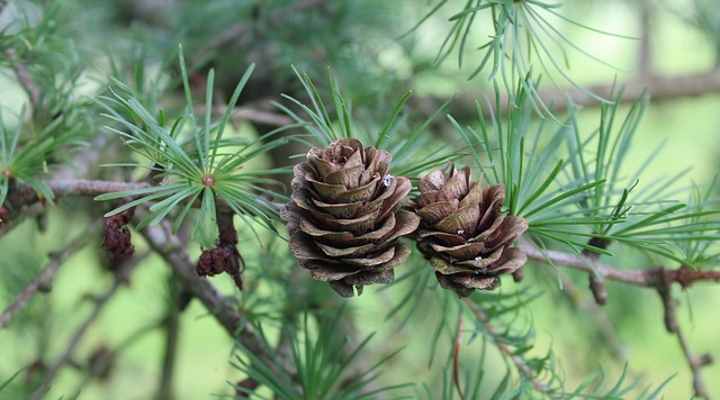
Larch tree mature cones – 2 female cones in the center and small male cones to the left
Like all true conifers, larch is a cone-producing tree. The cylindrical larch seed cones have an oval to egg shape and grow between 0.5” and 3.5” (1 – 9 cm) long. Northern larch species have the smallest cones, and southern larches have longer cones. Some species of larch are identified by green whisker-like leaves growing between the cone’s reddish-brown scales.
Larch Tree Identification
It’s easy to identify larch trees in the fall by their hues of warm yellow colors when their characteristic flat, pine-like needles turn yellow before falling to the ground. Larches also have identifiable pinkish or reddish-brown bark with shallow fissures. You can spot larches in forests by their oval cones and pyramidal growth habit.
Larch Trees in Winter
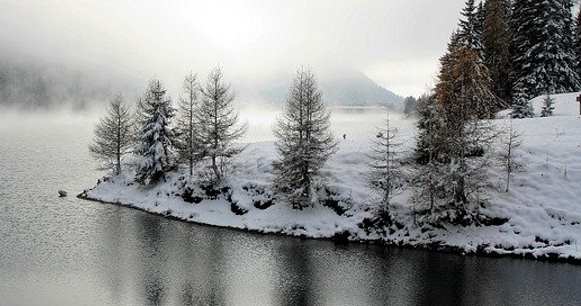
Larch trees lose their foliage in the winter
Larches are one of the few conifer trees to have bare branches with no foliage in winter. Noticing the lack of pine needles on larch trees is the easiest way to identify the species in winter. The fallen needle leaves create a pleasant-smelling mulch on the coniferous forest floor.
Because more light reaches the ground due to the lack of foliage, larches are among the few conifer trees to have winter or spring flowers growing around the root base. It’s not unusual to see a blanket of bluebells or other early spring flowers covering the ground under larch trees in winter.
Further reading: The Best Winter Flowering Plants.
Types of Larch Trees (With Pictures)
Let’s look in more detail at the various species of larch trees. For each variety of larch, you’ll find descriptions of the characteristics features of each tree to help identify it.
American Larch (Larix laricina)
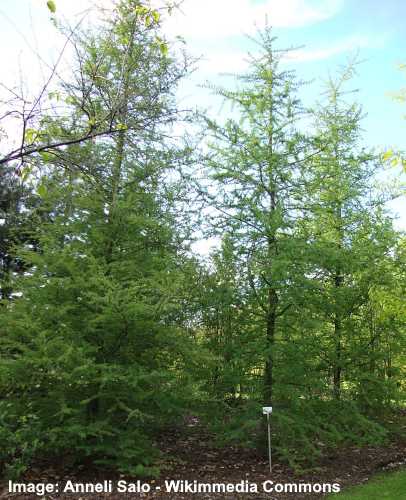
American larch tree (Larix laricina) is also called tamarack
The American larch (Larix laricina) is a medium-sized deciduous conifer with a conical shape, flaky reddish-brown bark, soft feathery needle foliage, and small cylindrical cones. Also called tamarack, American larch trees grow between 30 and 60 ft. (10 – 20 m) tall. Tamaracks are identifiable in fall by their bright yellow color.
American larches are native to Canada and the northeastern states of the US. American larch trees thrive in USDA zones 2 to 5. The deciduous conifers grow best in boggy soil or woodlands with poor drainage. The fast-growing larch is also an excellent specimen tree in a large landscape.
Called the red larch due to the bark’s color, mature American larches have reddish-brown, scaly bark. However, immature American larch is smooth and gray. The bark is characterized as thin and flaky when it’s mature.
Some species of American larch are tall, skinny trees with a slender, pyramidal growth habit. You can spot the slender larch in coniferous woodlands due to its branchless trunk and crown that starts growing halfway up the tree.
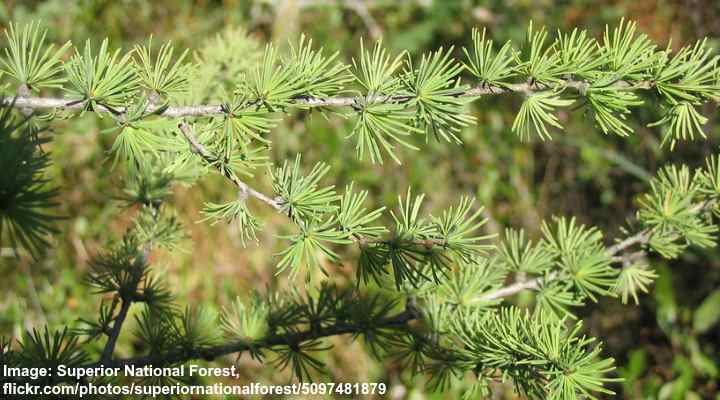
American larch leaves
American larch leaves (needles) are a light blue-green color in spring and summer. Each needle-like leaf grows around 1” (2.5 cm) long. Like all larches, the tamarack leaves grow in dense tufts on long woody shoots with up to 30 needles in a cluster. The larch leaves are arranged spirally on the branches.
American larch cones are some of the smallest of all conifers in the Larix genus. The conical cones measure between 0.4” and 0.8” (1 – 2 cm) long. As the cones appear on the larch, they are bright red. They gradually turn brown as they mature throughout the season. The mature larch seed cones release seeds about six months after pollination.
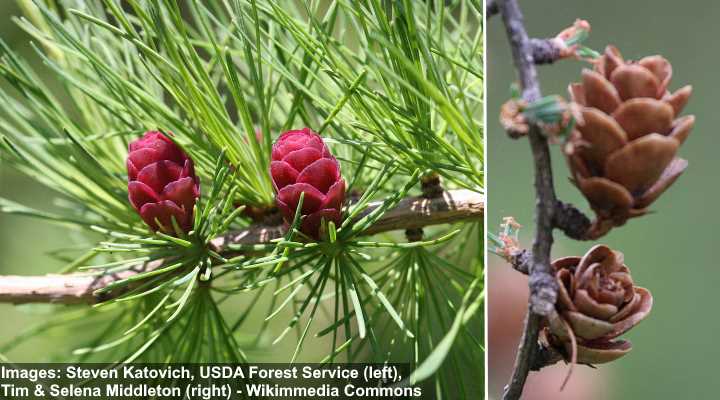
American larch flowers (left) and cones (right)
American larch flowers are another name for the immature colorful cones. The cones are referred to as flowers as they look like pinkish red clusters that stand erect on branches. When they emerge, the “flowers” are soft. But they harden and turn brown as they mature.
Western Larch (Larix occidentalis)
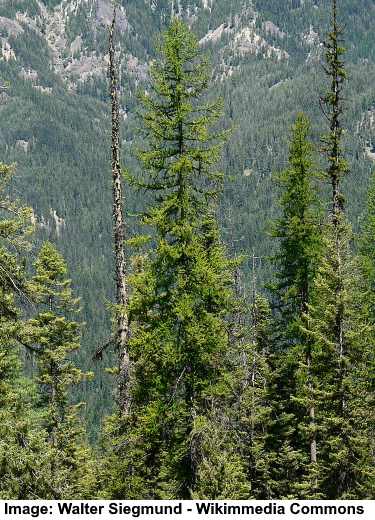
Western larch tree (Larix occidentalis)
The Western larch (Larix occidentalis) is a tall conifer with a slender, conical crown, flaky brown bark, and clusters of light green needle leaves growing from woody pegs. This large coniferous tree grows between 100 and 200 ft. (30 – 60 m) tall. The Western larch is identified by its narrow conical crown and bright yellow fall color.
The Western larch thrives in USDA zones 4 and above. Its native range is in the northwestern states such as Washington, Oregon, and Montana, as well as Canadian forests. Unlike the Eastern larch, the western larch only grows in well-draining soil. The tree can tolerate temperatures as low as -58°F (-50°C).
Western larches are distinctive conifers with notable growing features. Its growth is tall and slender. Its branches have clumps of needles like pine trees, and cones with distinctive whiskers sticking out beyond the scales and flaky gray or brown bark.
The Western Larch is one of the two larch species native to Washington state. The other is the alpine larch (Larix lyallii).
Western larches are sometimes referred to as hackmatack or western tamarack. Its timber is used for framing, construction, finishing work, and firewood. In many countries, western larches are important trees for the paper pulp industry.

Western larch leaves
Western larch leaves are soft, long, slender needle leaves that grow in small clumps arranged spirally on branches. In the fall, the light-green larch foliage turns golden yellow before the leaves drop, leaving bare orange-brown shoots throughout the winter.
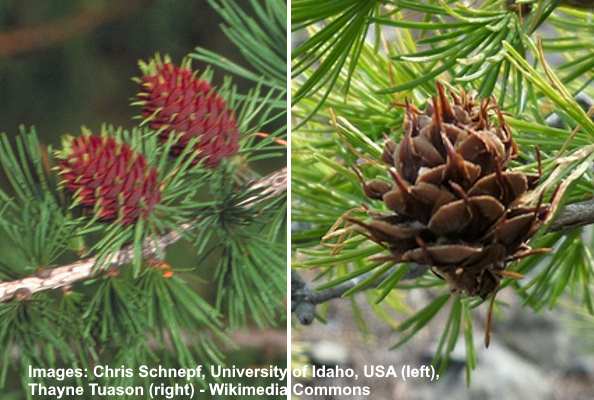
Western larch immature cones (left) and mature cone (right)
Western larch cones look like hemlock cones. The conical reddish cones have whiskery growths on the ends of the scaly bracts. Cones emerge as reddish-purple larch flower-like strobili before turning brown and releasing seeds about six months after pollination.
European Larch (Larix decidua)
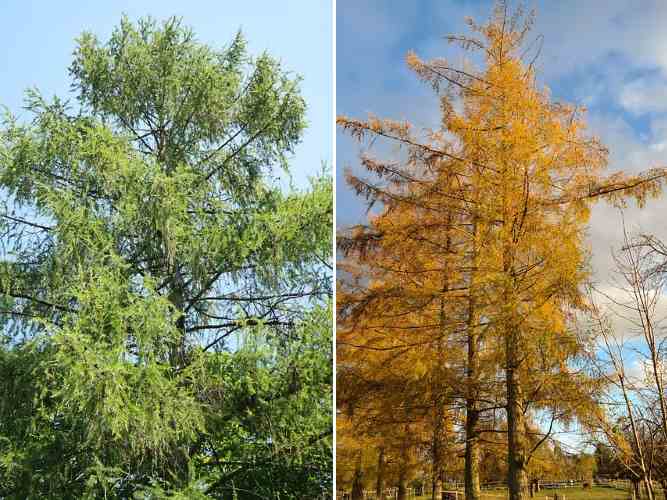
European larch (Larix decidua) trees
The European larch (Larix decidua) is a deciduous conifer that grows between 82 and 150 ft. (25 – 45 m) tall. You can identify the European larch by its conical crown and pyramidal shape, red cones that turn green then brown, and light-green needle-like leaves. In the fall, European larches turn bright yellow, brightening an evergreen forested landscape.
European larches are native to the mountainous regions of central Europe. The hardy conifers thrive in USDA zones 2 through 9 and withstand temperatures as low as -58°F (-50°С). For best growth, the European larch should be planted in well-drained soil and full sun.
In North America, you’ll find European larches in the mountainous regions of Appalachians, as well as in Michigan, Connecticut, Rhode Island, and New Hampshire. European larches tolerate warmer climates better than tamaracks. The European larch is also a popular ornamental tree.

European larch leaves and male cones
European larch leaves grow between 0.8” and 1.5” (2 – 4 cm) long. Typical of larch leaves, the needle-shaped leaves grow in small tufts arranged spirally on branches. The green leaves emerge from small pegs. They turn blue-green in summer then transform to golden yellow in the fall.
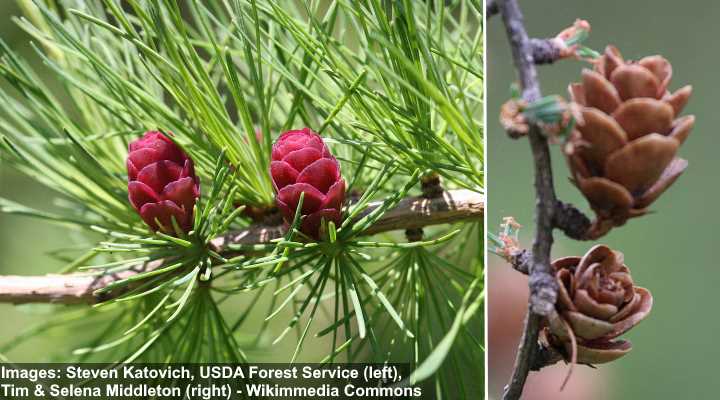
American larch flowers (left) and mature cones (right)
European larch cones emerge as reddish flower-like egg-shaped clusters. As the season progresses, the colorful bracts become brown before shedding seeds in the winter. Cones can persist on the larch for up to ten years, growing alongside newly emerging, colored cones.
Weeping Larch (Larix decidua ‘Pendula’)
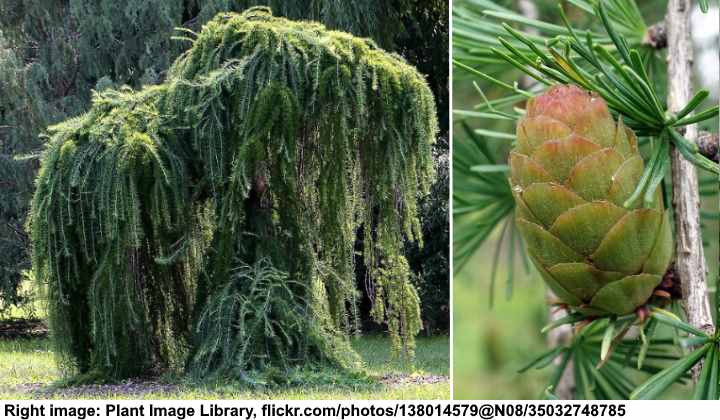
Weeping larch tree (Larix decidua ‘Pendula’) and immature cone
The weeping larch (Larix decidua ‘Pendula’) is a small, fast-growing ornamental tree with drooping branches, pine-like needle leaves, and narrowly ovate cones. The soft, tufty bright green needle leaves densely cover the pendulous branches. The dwarf larch grows up to 12 ft. (3.5 m) tall and 8 ft. (2.4 m) tall. The weeping larch is identified by its irregular crown and branches that droop to the ground.
Weeping larch is an ideal dwarf tree to plant if you have a small or compact backyard. In spring and summer, dense feathery foliage covers the weeping larch branches. In the fall, the larch turns a spectacular yellow before the soft needles fall to the ground.
You can plant a weeping larch in full sun and mildly acidic soil that drains well. The larch cultivar thrives in USDA zones 2 through 7. This stunning ornamental tree with its graceful cascading branches is ideal as a lawn tree, specimen tree, or growing in a large pot.
This dwarf weeping conifer is easily confused with the weeping Japanese larch (Larix kaempferi ‘Pendula’).
Japanese Larch (Larix kaempferi)

Japanese larch trees (Larix kaempferi)
The Japanese larch (Larix kaempferi) is a vigorous conifer with a conical shape, reddish-brown bark, blue-green clusters of needle leaves, and tiny purple cones. The deciduous larch grows between 65 and 103 ft. (20 – 40 m) tall. The larch is identified by its open, irregular horizontally spreading branching as the tree matures.
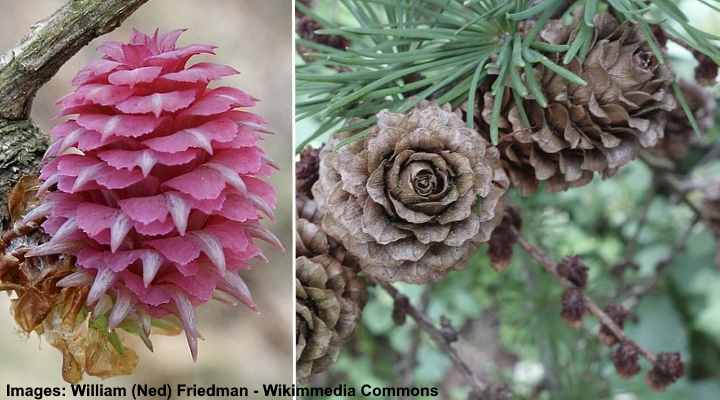
Japanese larch female flower (left) and cones (right)
The characteristics of the Japanese larch are small, erect conical flower-like strobili that emerge violet. The larch “flowers” develop into orange-brown cones before turning dark brown. The tree’s foliage color is gray to green in the summer before turning a spectacular bright yellow in the fall.
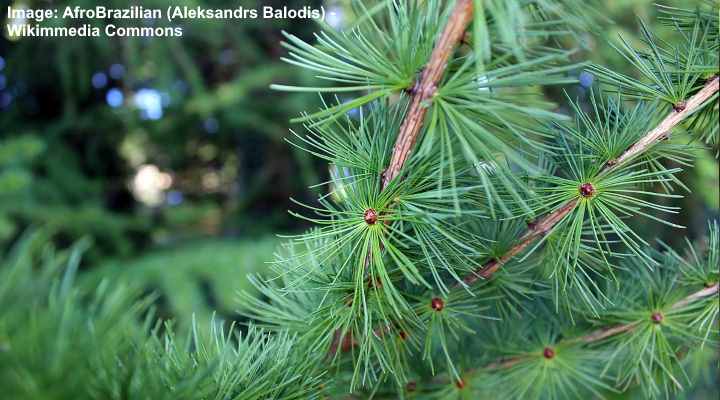
Japanese larch leaves
Due to its large size, the Japanese larch is suitable for large landscapes. The tree thrives in USDA zones 4 through 7 when planted in well-drained soil. However, the larch is also adaptable to soggy ground and can grow near streams or ponds.
There are various cultivars of Japanese larch to suit everyone’s taste. There is the miniature larch that is the Japanese larch bonsai.
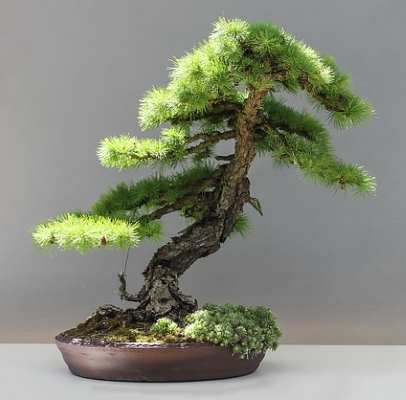
Japanese larch bonsai
Also, dwarf conifers growing between 3 and 4 ft. (1 – 1.5 m), such as ‘Blue Dwarf’ and ‘Nana,’ are ideal for potted larch trees or growing in compact gardens.
Weeping Japanese Larch (Larix kaempferi ‘Pendula’)
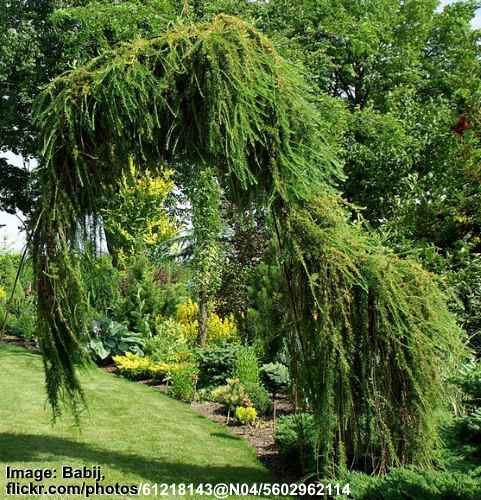
Weeping Japanese larch (Larix kaempferi ‘Pendula’)
The weeping Japanese larch is a beautiful cultivar with weeping branches that cascade with soft, feathery light green foliage. The dwarf coniferous tree can be trained as a mounding shrub, arching small tree, or weeping conifer. Its long trailing branches will even form ground cover for full sun.
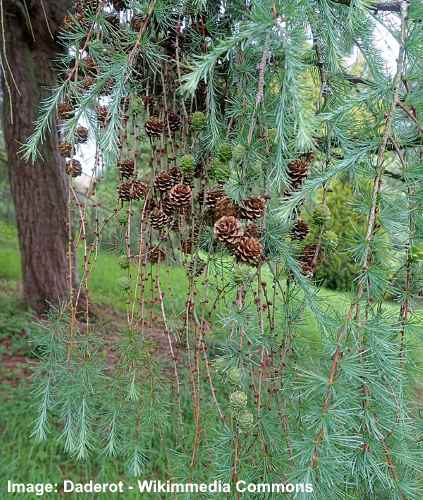
Weeping Japanese larch leaves and cones
The weeping Japanese larch ‘Pendula’ thrives in USDA zones 4 to 7. The fast-growing, small, hardy tree grows between 15 and 30 ft. (4 – 9 m) tall and up to 20 ft. (6 m) wide.
Siberian Larch (Larix sibirica)
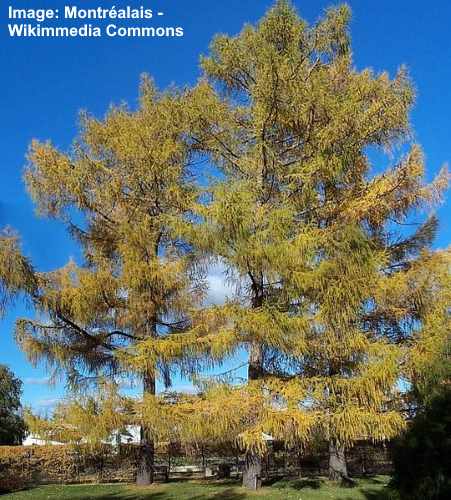
Siberian larch (Larix sibirica)
The Siberian larch (Larix sibirica) is a large conifer that loses its leaves in the fall. The stunning landscape tree is recognized by its horizontal branching, conical crown, and pendulous side branches. Siberian larches grow between 65 and 164 ft. (20 – 50 m) tall. The cold-hardy tree thrives in USDA zones 2 to 8.

Siberian larch leaves
Siberian larches have light-green, needle-like pine leaves growing in tufts of up to 40 leaves. The cones are barrel-like and oblong and measure between 0.8” and 2” (2 – 5 cm) long. Immature larch cones or flowers are pinkish-red and gradually turn into brown stiff seed cones.
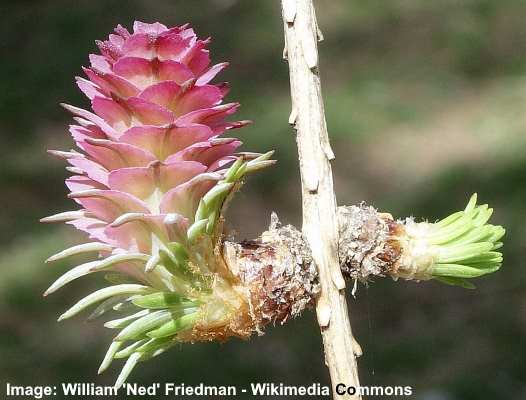
Siberian larch female flower (strobilus)
Other Types of Larch Trees
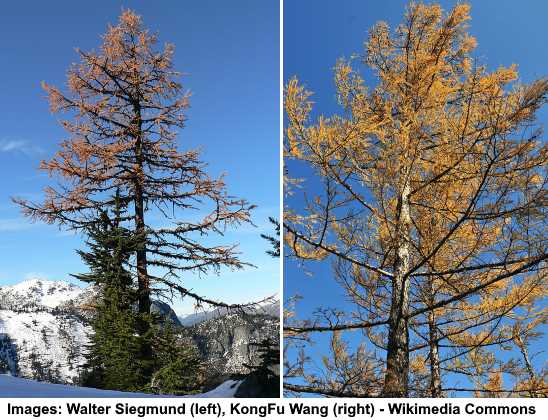
Alpine larch (Larix lyallii) on the left and Dahurian larch (Larix gmelinii) on the right
Apart from the main species of larch trees, there are a few more varieties native to North America, Europe, and Asia. Here are a few other types of larches:
Alpine larch (Larix lyallii)—The cold-hardy North American larch is a slender columnar tree that grows up to 80 ft. (25 m) tall in subalpine forests. The branches have needle leaves 2” (5 cm) long, barrel-shaped red cones with green whiskers and flaky gray bark.
Dahurian larch (Larix gmelinii)—This medium-sized European conifer grows between 32 and 98 ft. (10 – 30 m) tall. The cold-hardy larch has small ovoid, green cones and short needle leaves growing in tufts.
Related articles:
